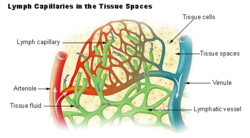
Back Limf Afrikaans لمف Arabic Limfa Azerbaijani Лімфа Byelorussian Пасака BE-X-OLD Лимфа Bulgarian লসিকা Bengali/Bangla Limfa BS Limfa Catalan Lympha CBK-ZAM
| Lymph | |
|---|---|
 Diagram showing the formation of lymph from interstitial fluid (labeled here as "Tissue fluid"). Note how the tissue fluid is entering the blind ends of lymph capillaries (shown as deep green arrows) | |
| Details | |
| System | Lymphatic system |
| Source | Formed from interstitial fluid |
| Identifiers | |
| Latin | lympha |
| MeSH | D008196 |
| TA98 | A12.0.00.043 |
| TA2 | 3893 |
| FMA | 9671 |
| Anatomical terminology | |
Lymph (from Latin lympha 'water')[1] is the fluid that flows through the lymphatic system, a system composed of lymph vessels (channels) and intervening lymph nodes whose function, like the venous system, is to return fluid from the tissues to be recirculated. At the origin of the fluid-return process, interstitial fluid—the fluid between the cells in all body tissues[2]—enters the lymph capillaries. This lymphatic fluid is then transported via progressively larger lymphatic vessels through lymph nodes, where substances are removed by tissue lymphocytes and circulating lymphocytes are added to the fluid, before emptying ultimately into the right or the left subclavian vein, where it mixes with central venous blood.
Because it is derived from interstitial fluid, with which blood and surrounding cells continually exchange substances, lymph undergoes continual change in composition. It is generally similar to blood plasma, which is the fluid component of blood. Lymph returns proteins and excess interstitial fluid to the bloodstream. Lymph also transports fats from the digestive system (beginning in the lacteals) to the blood via chylomicrons.
Bacteria may enter the lymph channels and be transported to lymph nodes, where the bacteria are destroyed. Metastatic cancer cells can also be transported via lymph.
- ^ "lymph". Merriam-Webster.com Dictionary. Retrieved 29 May 2010.
- ^ Fluid Physiology: 2.1 Fluid Compartments
© MMXXIII Rich X Search. We shall prevail. All rights reserved. Rich X Search